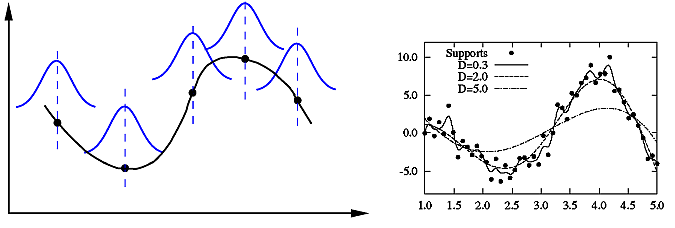In the Moving Least Squares (MLS) approximation (Lancaster and Salkauskas 1981) a local character of the regression is obtained by introducing position-dependent radial weighting functions. MLS approximation can be understood as an extension of the polynomial regression. Similarly the basis function can contain every type of function, but generally only linear and quadratic terms are used. The approximation function is defined as
(2–14) |
with changing (“moving”) coefficients a(x) in contrast to the constant global coefficients of the polynomial regression. The final approximation function reads
(2–15) |
where the diagonal matrix W(x) contains the
weighting function values corresponding to each support point. Distance-dependent
weighting functions have been introduced. Mostly the well known Gaussian weighting
function is used
(2–16) |
where the influence radius D directly influences the approximation error and α is a numerical constant. A suitable choice of this quantity enables an efficient smoothing of noisy data. In Figure 2.6: Local Weighting Principle and Smoothing Effect the local weighting principle and the smoothing effect is shown.
|
|
|
Local weighting of support point values (left) and influence of the influence radius D on the smoothing of the MLS approximation function (right). |
The MLS approach has the advantage that no training is necessary before an approximation point can be evaluated. At each point only the weighting factors and the local polynomial coefficients have to be calculated. This makes this method very fast compared to other approximation techniques.



